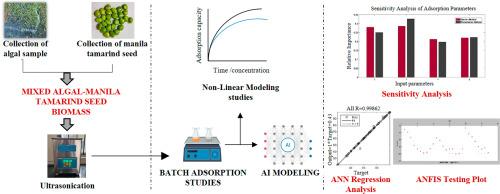Comparative evaluation of artificial intelligence based prediction of dye removal by ultrasonic activated carbon composites derived from mixed biomass: Optimization and sensitivity analysis using Garson and Pertubation method
IF 5.1
3区 材料科学
Q2 MATERIALS SCIENCE, COATINGS & FILMS
引用次数: 0
Abstract
Development of efficient and sustainable adsorbent along with predictive tools has become crucial for the effective pollutant remediation strategies. The current research introduces a novel integration of ultrasonication modified algal-manila tamarind seed biomass (UAMTB) with Artificial intelligence based predictive modelling for the effective dye removal. The potential surface and functional nature has been analysed by material characterization studies. Highest adsorption capacity of 298.85 mg/g for Basic Orange (BO) and 283.88 mg/g for Eriochrome Black (EB) dye has been observed at UAMTB dose of 1.2 g/L within a time interval of 25 min. In the AI model training comparing Artificial Neural Network (ANN) and Adaptive Neuro Fuzzy Inference System (ANFIS), best performance was obtained for the tansig purelin model with optimal neural architectures of [4 25 1] for BO dye and [4 30 1] for EB dye with higher R value of 0.9977 and 0.9986 for EB and BO dye respectively in ANN model. The Mean squared Error (MSE) value for the tansig-purelin model was found to be 0.0012 with ANN model which was higher than ANFIS MSE value of 1.13. Sensitivity analysis using Garson and Perturbation method observed that the UAMTB dose is the most influential input variable in the current adsorption process. The dual model approach of sensitivity analysis validates the efficacy of ANN modelling for process optimization in complex adsorption systems.

基于人工智能的混合生物质超声活性炭复合材料脱色预测的比较评价:基于Garson和pertuation方法的优化和灵敏度分析
开发高效和可持续的吸附剂以及预测工具对于有效的污染物修复策略至关重要。本研究介绍了一种将超声波修饰藻马尼拉罗望子生物量(UAMTB)与基于人工智能的预测模型相结合的新型方法,用于有效去除染料。通过材料表征研究,分析了其潜在的表面和功能性质。在UAMTB剂量为1.2 g/L、间隔25 min的条件下,对碱性橙(BO)和铬黑(EB)染料的最高吸附量分别为298.85 mg/g和283.88 mg/g。在人工神经网络(Artificial Neural Network, ANN)和自适应神经模糊推理系统(Adaptive Neural Fuzzy Inference System, ANFIS)的AI模型训练中,tansig purelin模型表现最佳,其最优神经结构为BO染料[4 25 1]和EB染料[4 30 1],ANN模型中EB和BO染料的R值分别为0.9977和0.9986。ANN模型的均方误差(MSE)为0.0012,高于ANFIS模型的均方误差(MSE) 1.13。采用Garson和摄动法进行敏感性分析,发现UAMTB剂量是当前吸附过程中影响最大的输入变量。灵敏度分析的双模型方法验证了人工神经网络建模在复杂吸附系统过程优化中的有效性。
本文章由计算机程序翻译,如有差异,请以英文原文为准。
求助全文
约1分钟内获得全文
求助全文
来源期刊

Diamond and Related Materials
工程技术-材料科学:综合
CiteScore
6.00
自引率
14.60%
发文量
702
审稿时长
2.1 months
期刊介绍:
DRM is a leading international journal that publishes new fundamental and applied research on all forms of diamond, the integration of diamond with other advanced materials and development of technologies exploiting diamond. The synthesis, characterization and processing of single crystal diamond, polycrystalline films, nanodiamond powders and heterostructures with other advanced materials are encouraged topics for technical and review articles. In addition to diamond, the journal publishes manuscripts on the synthesis, characterization and application of other related materials including diamond-like carbons, carbon nanotubes, graphene, and boron and carbon nitrides. Articles are sought on the chemical functionalization of diamond and related materials as well as their use in electrochemistry, energy storage and conversion, chemical and biological sensing, imaging, thermal management, photonic and quantum applications, electron emission and electronic devices.
The International Conference on Diamond and Carbon Materials has evolved into the largest and most well attended forum in the field of diamond, providing a forum to showcase the latest results in the science and technology of diamond and other carbon materials such as carbon nanotubes, graphene, and diamond-like carbon. Run annually in association with Diamond and Related Materials the conference provides junior and established researchers the opportunity to exchange the latest results ranging from fundamental physical and chemical concepts to applied research focusing on the next generation carbon-based devices.
 求助内容:
求助内容: 应助结果提醒方式:
应助结果提醒方式:


